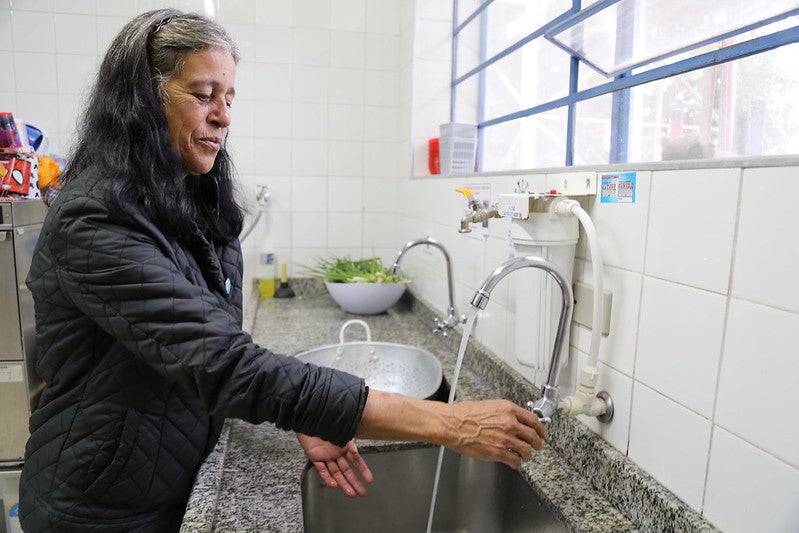 Mulher abre torneira, água sai
Mulher abre torneira, água sai
The public sector needs innovation. As societies develop, their problems become more complex, and the demand of citizens for quality services increases . To keep up with the pace of change and meet citizens’ demands in an efficient and sustainable manner, the public sector has no choice but to find new solutions to challenges. However, innovation within the public sector in Latin American countries, although growing, is not yet the norm .
Take for example the experience of the state of Pernambuco, Brazil, where the water and sanitation sector faces complex challenges such as climate change, increased pollution, rapid urbanization, and population growth, among others. On top of this, COMPESA, the state's water and sanitation utility, experiences above-ideal levels of non-revenue water, or “leakage” from the system.
While some losses are due to structural or operational inefficiencies such as leaky pipes, others are due to clients installing bypasses to consume water free of charge or defrauding the hydrometers to reduce the consumption registers. Even though structural and technological solutions are fundamental to address these issues, COMPESA recognizes the importance of also using innovative approaches to redesign its processes and services.
COMPESA partnered with the World Bank’s Water Practice and the Mind, Behavior, and Development (eMBeD) team within the Poverty and Equity Practice, with financing from the United Kingdom Prosperity Program to set up a plan to embed innovative approaches into the company´s operations, focusing specifically on issues around customer payments and connectivity, aiming at increasing on-time payment, and reducing illegal connections.
Users at the center
The innovative approach includes adopting perspectives that put the users at the center, such as human-centered design (HCD) and behavioral sciences. These valuable approaches place a focus on understanding the problem(s) and examining the user needs and barriers that prevent them from performing the desired behavior. They rely on participatory approaches, rapid prototyping of solutions, and experimentation to implement promising solutions.
A five-step strategy based on a bottom-up approach within COMPESA’s decision-making structure was enacted to drive innovation:
- Getting buy-in from decision-makers. We spent a year working hand-in-hand with COMPESA’s staff, involving them in different research activities addressing challenges in their operations (including a behavioral diagnostic and consequent pilot experiment), and including teams in every step of the key decision-making processes.
- Training mid-level managers. At this point, the need for more formal training and capacity building had become salient. Evidence from other studies indicates that frontline staff and mid-level managers often have the best understanding of the need to innovate in an organization. Hence, the team organized a four-day HCD training for 50 mid-level managers and analysts from multiple units of the utility, during which the trainees identified problems that could be solved by focusing on the end-user.
- Selecting ideas, developing projects, testing potential innovative interventions, and guaranteeing internal buy-in to these innovations. After the training, a “Design Thinking Festival” was held. Eight project ideas were presented, and two were chosen by some of COMPESA's Directors to be implemented. Staff members from those two projects were invited to undergo a four-month mentorship program, guiding them through the process of transforming an innovative idea into a real project.
- Training the trainers. As part of integrating the HCD approach in COMPESA, it was essential to disseminate what was learned by a few staff to the entire utility. A group of 12 mid-level managers and analysts were trained for five days to be active multipliers of innovation and of the HCD approach.
- Training high-level managers. The previous steps received such a positive feedback that COMPESA’s leadership team requested a tailored training for them to include HCD and behavioral science approaches. A total of 22 participants, including six Directors and the company’s President, were very much engaged and committed throughout the three to four-hours sessions in the evenings for three days. As a result, the dissemination of the new innovative approaches reached the top of the organization, expanding reach and creating additional opportunities for staff in COMPESA to sell ground-breaking ideas to their leaders, who will now have a shared understanding of the importance of innovating using HCD approaches.
Training of the high-level managers., February 10th, 2021
In total, we trained over 84 members from various units and backgrounds. COMPESA’s management has decided to create a corporate program to incorporate innovation into the routine of its employees.
This program, to be called “Caravana da Inovação” (the Innovation Caravan), will be responsible for creating and maintaining regional innovation hubs, formed by staff interested in innovating in their areas of expertise. We are very excited to see how this initiative evolves!







Join the Conversation